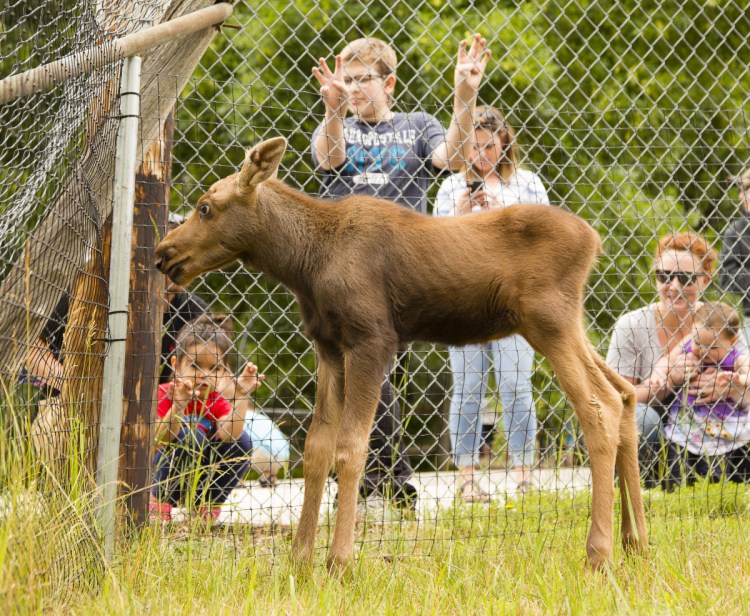GRAY — The Maine Wildlife Park’s newest resident is already an internet celebrity.
The 3-week-old female moose calf, who melted hearts across the country in a viral video of her with the dog of the family that found her in northern Maine, is now living at the 40-acre wildlife park off Route 26 in Gray.
Park Superintendent Curtis Johnson said it’s unclear if the roughly 40-pound calf – named Miss Maggie by the family in the Aroostook County town of Wallagrass that found her – can be rehabilitated and reintroduced into the wild or will remain at the park permanently.
“We don’t know yet what’s going to become of this calf in terms of will she be released, (or) because of all the human care will she have to stay in captivity at a place like ours,” Johnson said.
The park is run by the Maine Department of Inland Fisheries & Wildlife.
Johnson noted that the park does not usually rehabilitate animals, and generally just takes in those that cannot be released back into the wild. But the moose calf and two deer fawns now at the facility could be exceptions depending on how they progress.
“Moose calves in particular are very, very delicate,” he said. “They have specific dietary needs, and it’s hard to simulate those natural foods in captivity. No milk is as good as mother’s milk.”
The moose and deer are bottle-fed every 3½ to four hours, and will start on solid food in the upcoming weeks, he said.
Johnson said moose are “more docile” and more easily imprinted on than deer are, and he expects to know whether the calf can return to the wild sometime this summer.
If the calf ends up staying at the park, she could eventually be integrated with the three other moose already on the property, but for now she is kept by herself.
“Even as adults, they are hard to keep,” said Johnson, adding that an adult moose can eat up to 50 pounds of food per day.
Johnson was unaware of any other facilities in Maine that are able to rehabilitate moose.
“It’s a rare occurrence,” said Lee Kantar, DIF&W’s state moose biologist, about finding a young moose alone and alive in the wild. “We don’t see this very often.”
Like Johnson, Kantar described the process of raising a baby moose in captivity as a difficult one.
“The challenge then is getting a newborn calf through the summer, I think,” Kantar said. “The whole mother’s milk thing can’t be overstated.”
Kantar said the animals can grow to over 400 pounds within their first year.
“It’s just astronomical the amount of growth that happens,” Kantar said.
Johnson said young moose aren’t generally abandoned except in situations where the mother may have been injured or killed.
“The average animal that’s found alone is alone for natural reasons and natural causes,” he said. Mother deer and moose will sometimes leave their young for hours to look for food.
DIF&W encourages people who encounter seemingly abandoned animals to leave them alone when possible, using the slogan: “If you care, leave them there.”
In some cases, Johnson said, bringing a wild animal into captivity can amount to a “death sentence.”
Johnson said he couldn’t speculate as to why this calf was found alone, but focused on the positives of having the moose at the park, which he called an “educational opportunity to tell people all about moose, and moose management, and the species, and how they’re doing right now in the state of Maine.”
He said the addition of a new animal can sometimes help bolster visibility and attendance at the park, and further its mission of wildlife education.
“This is an exceptional case because that video, of course, went viral. And the coverage has been on a national level,” Johnson said.
Matt Junker can be contacted at 781-3661 ext. 123 or at:
mjunker@keepmecurrent.com Twitter: MattJunker
Send questions/comments to the editors.



Comments are no longer available on this story